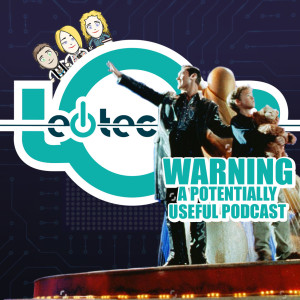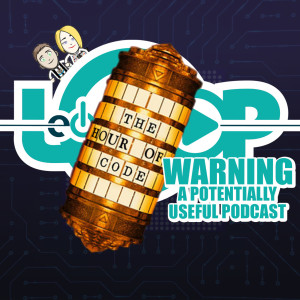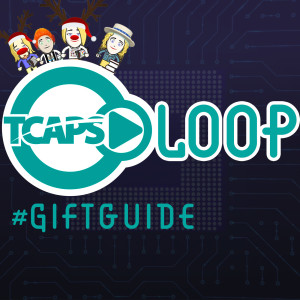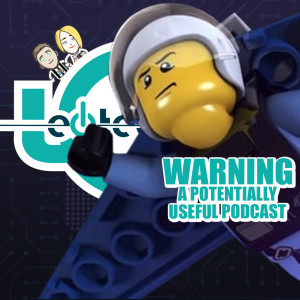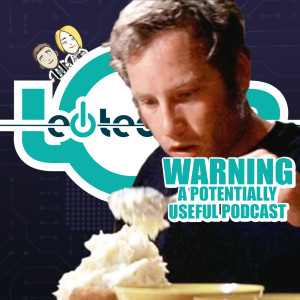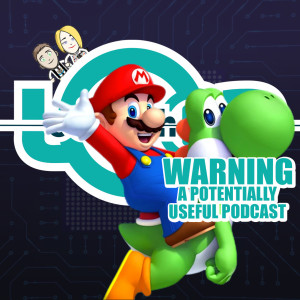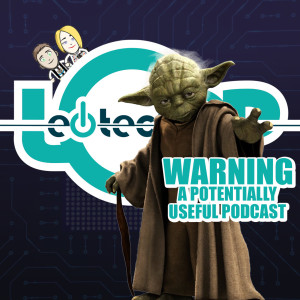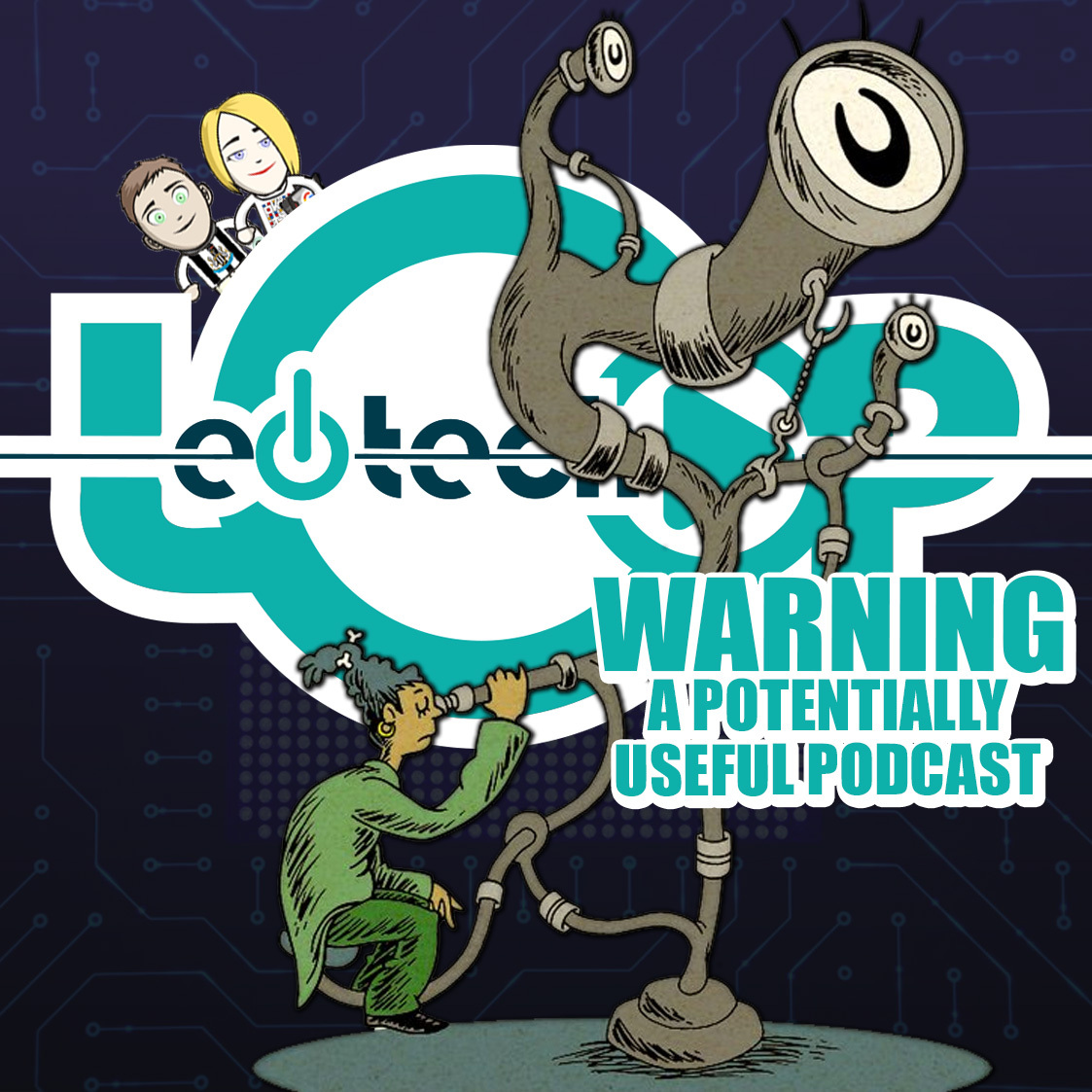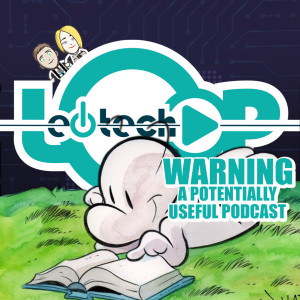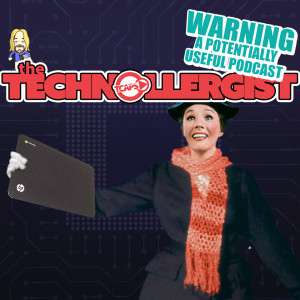The EdTechLoop Pod is joined by a special guest this week as TCAPS STEM Coordinator, Heidi Skodack, shares her thoughts on the upcoming Hour of Code activities and STEM opportunities for students of all ages. Get involved in the "Hour of Code" December 9-15!
Show Transcripts
Larry Burden 0:04 Whatever you say is etched in stone.
Or at least when I was doing the little research that I did.
Heidi Skodack 0:13 Do you agree?
Danelle Brostrom 0:14 I do,
Larry Burden 0:15 We have to be able to hear you.
Heidi Skodack 0:16 Okay, this could go really bad.
Larry Burden 0:19 I am unconcerned.
It's Episode 99 of the EdTech Loop podcast, my name is Larry Burden and she still hasn't figured out how the zombies got into her Minecraft castle, it's Danelle Brostrom, and at long last, our quest is complete, as we joyously welcome TCAPS STEM Curriculum leader Heidi Skodak. I know you have many other titles, but we're just gonna stick with that one. Through a process of trial and error, I have crafted this week's moment of Zen.
Moment of Zen 0:51 I have been impressed with the urgency of doing. Knowing is not enough. We must apply. Being willing is not enough. We must do.
Larry Burden 1:01 A little Leonardo da Vinci for you there. We've eliminated all the unnecessary ingredients so we could truly appreciate the flavor of this week's meat of the show. Hour of Code. So every year, somehow when we do these podcasts, we make mention of the Hour of Code. We kind of, this is a really cool thing we should get involved in, after the podcast where we've mentioned it, we go, next year we need to have somebody on to discuss this before the Hour of Code so that we can get more people involved. So this year we have the person that knows it all.
Heidi Skodack 1:37 Definitely not the case, nobody can know it all.
Larry Burden 1:39 Definetly no the case, I was talking about Danelle.
Danelle Brostrom 1:43 No, no. We can dive right in though.
Larry Burden 1:45 Alright dive right in, I know you have a bunch of questions and I'm gonna throw a lot. I was mentioning to Danielle before the podcast that this is... I'm looking for some marketing materials here, because I have a daughter that's about ready to go off into college, who's a Maker but doesn't really realize that she's a Maker. And I've been trying for years to get her involved, a little bit more involved in, and we're discussing this earlier, Computer Sciences, computer programming, STEM, coding, whatever you want to call it. So I'm going to use all these materials, all the things that we're getting today on her.
Heidi Skodack 2:20 That's perfect, you have the sleeper makers are the best. They don't realize they like STEM and computer science, until they've actually gone and done job experiences or job shadows with other people to realize what they actually love to do is create and make and, in the space called early STEM.
Danelle Brostrom 2:38 So why, why are colleges and businesses, the workforce, why are we pushing kids to do STEM? Why are they looking for kids that are interested in STEM?
Heidi Skodack 2:47 There's a long answer and a short answer to that. The short answer really is that the jobs of the future really are going to be related to computer science, and science, technology, engineering, and math and how those you bring together to actually develop careers, based on those things. So computer scientist is one area that is a big push right now. They talk about, at code.org, they talk about the different areas and careers that you can go into related to STEM.
Larry Burden 3:15 So, again, huge researcher me. Not really. It seems like there is a giant gap in what industries need, what our job force, what is needed in the job force and what we are actually preparing kids for. How are we setting up kids, you know, through the Hour of Code, and through our programming in our classrooms, how are we setting kids up to be introduced to coding, or computer science?
Heidi Skodack 3:43 Well I think we have a lot of work to do. We certainly aren't where we need to be K through 12. And it's a difficult task because you're really thinking about things, and jobs of the future that don't exist yet. So that's, that's a big hurdle to overcome but getting students exposed at the earliest age; kindergarten, first grade, second grade, you know, that's where it all starts in jobs the future. If you're at all in tune with things that are happening in Traverse City there's, you know, a group called TC Connect, which has now joined up with the Chamber of Commerce, to talk about where the jobs are going to be in the future in Traverse City, and their goal really is to bring high tech jobs back to Traverse City, so our Boomerang students, our kids right, who go off to college and get a, or have education in the area of computer science, programming anything STEM, when they come back they have jobs. And so they recognize the need, our local need for building that capacity in our students and it has to start in K through 12. So how do we build that capacity at a young age, which means building capacity of the teachers to recognize the importance of implementing some STEM based activities and computer science activities in the classroom starting in kindergarten.
Danelle Brostrom 4:56 Do you think it's a, think it's a hard sell or do you think that's an easy sell. When you go out and talk to teachers about this, the new kinds of skills that our students need, do you, are teachers nodding and being like, Yeah, let's do it, let's go, or do they have some hesitations? Can you talk about that?
Heidi Skodack 5:12 I don't think I've run into anybody who has said, Do we really need that?
Danelle Brostrom 5:16 That's crazy.
Heidi Skodack 5:18 Yes, exactly. But I do run into apprehension because when I mean we're going to talk about really, you know, Hour of Code, I do run into some pushback in, I don't know how to code, how can I teach my kid, I have no experience at all in computer science or coding, how, how am I going to be able to teach that to my students? And so that's really what the conversation, that's where you get pushback from is, how can I do it I've never done it myself. Because as a teacher, you always want to be the expert in the room. Well those days are kind of gone. You have to be sometimes learning with the students on new ideas in, especially related to computer science.
Larry Burden 5:54 I have a weird question, and this is this kind of came to me right before the podcast. It's odd because when I was in high school, a millennia ago, there was a computer programming class, we had to take computer programming, it was just, it was one of those things, we think this is going to be important so we learned how to like, you know, do the if and then type of statements and it was really really basic, and then it seemed to like drop off the map for a while. And obviously now it's starting to be, starting to become re-ingrained in what we do, but why did it between the late 80's, early 90's and now, there was a gap where, I mean it was always it's kind of there but as far as a priority, a curricular priority, I don't think it was there.
Heidi Skodack 6:40 And that is absolutely true. What happened I mean, that was one of those like, Oregon Trail. Right?
Larry Burden 6:46 Exactly.
Heidi Skodack 6:47 Elementary school.
Danelle Brostrom 6:48 Right.
Heidi Skodack 6:49 So, but I do, I do think there in, in the past, you know, in the 90's people were using coding to do very particular jobs, right. And now everything you touch, a lot of times has some sort of coding in it. I mean, think about your cars, or your phones. I mean that was prior to cell phones really, that where everybody had a cell phone. So the technology that's been developed and just the amount of code that's needed to run those devices, and those different things has completely changed. So before it would be something large, like, you know when you're thinking about NASA, right? They're going to use, we would expect to see a bunch of coding in the 90's. But we didn't expect all those personal devices, and how rapidly the technology changed for the demand for that coding piece, and I also think it is part of that Maker Movement when you're able to go online and YouTube questions and answers on what you're trying to do yourself, and to try to problem solve those things, and do coding yourself. You can find thousands of web, websites that actually teach coding to all age groups.
Danelle Brostrom 7:54 That is the most amazing piece of this. My nine year old wants an alarm for her bedroom door for Christmas, that can keep her sister out. And I can go,
Heidi Skodack 8:03 She's gonna make it right.
Danelle Brostrom 8:04 Exactly, that's the thing. Because of course that's what she wants. But we can buy one for like $40 on Amazon, and it's this kid friendly, blah, blah, blah, that has a swipe card and stuff, or I just googled, how to do it, and found awesome instructions that were in plain English, with items I can go purchase right here, and I'm just gonna give her a box of stuff and she's gonna build it, and she's gonna code it. Like we can we can get the Raspberry Pi, we can do all these things that can make things happen and I think that's exciting for kids, and that's exciting for us, and it's incredible to me the amount of what you can do yourself really.
Heidi Skodack 8:40 And just the language like Raspberry Pi, right?
Larry Burden 8:43 yeah
Heidi Skodack 8:43 A lot of parents are like, the kids will ask for a Raspberry Pi and they're like, that's an easy gift. Run down to Grand Traverse Pie Company and pick up a rasberry pie.
Danelle Brostrom 8:51 We could get one of those too but.
Larry Burden 8:53 Just had one of those a couple days ago for Thanksgiving. It was fabulous.
Heidi Skodack 8:58 That's the interesting piece is that language sometimes, there's a language barrier between kids and their parents. And a lot of times they're purchasing things for their students that are related to technology, and coding, and computer science that they know nothing about. They recognize very clearly the need for, you know, exposing their students to new and different things related to those areas but a lot of times they don't know anything about it. So it's, it's scary, because there's the technology piece, like a lot of times what you deal with Danelle, balanced with dude, they're asking for something about STEM and computer science, tell me what else you want?
Danelle Brostrom 9:36 Yes, yes. So you mentioned the apprehension and not completely knowing everything and I totally see that when I'm out working with teachers, so tell us by the Hour of Code is such a perfect introduction, um such a perfect vehicle for teachers to do this.
Heidi Skodack 9:49 So the Hour of Code walks teachers with zero, or anybody for that matter, because I mean, part of the goal is to get the teachers interested with their students. The other is, how do we engage parents to do the Hour of Code at home, so they can actually see not only how easy it is, but the resources that are available for them to help their students in the future. So Hour of Code is a step-by-step, small little videos that if you're in the lower El. grades, you can show the video on your screen and then do the steps with the students on their own devices that they have. But really walks them through step-by-step and engaging things. So the, the new one really this year, or maybe it was out last year is dance party. So everyone likes dance party because students get to develop a character that does certain dance moves. You can make it dab right?
Danelle Brostrom 10:40 To Old Town Road, I may have been doing in my office this morning, it happens.
Heidi Skodack 10:43 You can select, you know, is it a bear, is it a frog, and then select the music that the frog will dance to, and really walk them through the process of movement and using block coding, which is really the basic beginning part of coding is drag and drop. So, it really, very descript, tells you exactly what is going to happen, and then you select features, and then you drag and drop to take those blocks and put them into a program. So it does give you the option if you're more advanced to actually see the code that's actually spitting out. Because you and I remember the days of, you know, what code looked like is very different. Block coding wasn't around and you are actually typing all those things and putting, you know, your pseudo code next to it so the next person who comes behind you, knows what you are coding. So, very different, very accessible, drag and drop clicks. If you don't get it right, there's a helper at the top that you can click on and it will walk you through the steps to fix your programming if it doesn't work. Typically, you can do it under an hour, a lot of times if you have, if you're little kids a lot of times play with video games and things like that. So, it might take you under an hour to do it. Usually kids are faster than the teachers, when the teachers are just learning. But everybody has fun. Jame McCall is gonna do a little coding session for us too. We want to show how easy it is. I'm gonna see if I can recruit some, a couple principals.
Larry Burden 12:08 If she could do it, everybody can do it.
Heidi Skodack 12:10 Yes.
Larry Burden 12:11 Sorry Jame, sorry,
Heidi Skodack 12:13 So just to, just to show people with no experience have gone in and done a lesson on coding in an hour or less. And just that exposure to just that process, that thinking process of what do I want to do, you have to really think about what your end product is.
Danelle Brostrom 12:29 Code.org has done an amazing job of bringing in all these different Hour of Code resources. They are there aren't just, you know, four or five that you get to pick from. There really are, maybe 100 different ones.
Larry Burden 12:39 So many.
Danelle Brostrom 12:40 Yep, and some are unplugged so some don't use any devices. There's some, some really really basic ones that are great for pre-readers, where they're just moving along. And then there's, like, like how you mentioned, the ones that are all the way where you can actually write the code, and you can actually develop your own app., or create something from scratch. I think the, the amount of options that are there can sometimes be overwhelming too, but as a teacher I just grabbed one and started playing it and was like, Oh, this one would be great for my kids. And like that, that's an easy way to, to kind of get started. And I cannot stress how user friendly the products are too, because I've been in a classroom with kids, and the kids are like, I'm stuck I don't know where to go, and I look at it and I have no idea where to go, and I can't figure out what the problem is, and I just asked. I'm like hey, anyone got puzzle eight on the Star Wars one, and then some kid comes over and helps them and I'm like woo. Yes, I don't have to do that one. But, just to see the kids persevere and get help from their neighbors, like there's, there's so many good skills that are happening when kids are doing this Hour of Code.
Larry Burden 13:41 I can't stress this enough, pre-reader. This is for every single classroom in any school district, even without a device. I was talking to my wife this morning about Hour of Code. She has a toddler classroom.
Heidi Skodack 13:41 Yes,
Larry Burden 13:42 I'm pretty sure there's probably something for your classroom.
Heidi Skodack 13:55 Yes there is, Pre-K.
Larry Burden 13:59 So toddler, toddler, all the way to your seniors, every classroom in the school district, could be doing something involving Hour of Code. That's so cool.
Heidi Skodack 14:12 And that's just a drop in the bucket, I mean Hour of Code is a drop a bucket. But it really could spur some interest in other things for the students. So, well worth it. So, I mean that's why we want to really blow up Hour of Code, create a little competition. I know really it's a joint collaboration between, you know STEM and the Technology Department to be able to support teachers as they attempt to do the Hour of Code with their students. So I'm really excited about it.
Larry Burden 14:40 So, I have a question. How do we embed STEM education, this the big, this is the big question. This is going right in there. How do we embed STEM education in our curriculum, especially in that Lower-El, Upper-El area. You know, we have classes, and we're developing more classes in our high schools, in our middle schools. I don't think we've got enough, really, to and I don't think it's, it's mandated, the way we would probably really need it to be for it to be successful, as successful as it should be in our public schools, but I really think due to time constraints or, again, some mandates, what can we do to get it more embedded in our curriculum in those elementary years? Big question.
Heidi Skodack 15:29 Well that, that is the question. I thought you had the answer to that.
Larry Burden 15:35 Way above my pay grade.
Danelle Brostrom 15:36 I promised her not difficult questions Larry.
Heidi Skodack 15:40 That actually is an excellent question. It's one that we have struggled with for a long time because of the time constraints especially Elementary. So, one of the biggest things that came into play was, if we were talking about our Math and ELA, there's a little bit of a hierarchy to, you know, core curriculum. So, a lot of times, ELA and Math gets the majority of the time that teachers spend. And then Science and Social Studies, and the question is is where does STEM fit in. Because STEM stands for: Science, Technology, Engineering, and Math, and it's not those individually, it's the collaboration of all together, right? So where do we find places in the curriculum that already exist, where we can make sure that we're identifying and emphasizing those STEM activities that are taking place. It's really project-based, hands-on learning and the integration of all of that together. And so, the biggest question we had is, how are we going to fit it in? Our answer right now is that we are implementing the FOSS Science Curriculum, right. We're trying to kill two birds with one stone because FOSS has STEM embedded activities within the FOSS program. And so it's not only teaching science, but the students in their activities are incorporating those STEM pieces in there. So we're not only covering topics within, how you do a project-based learning related to STEM, but we're also covering our science standards within there. And so our avenue right now is using the FOSS curriculum to embed some of those STEM activities. Because, I was constantly brought back to the fact that we can do all these outside STEM activities: robotics, tech-girls, you know recycle racers, and the things that we offer in the district, but our goal is to reach every single student, and how do we give every single student the opportunity. Science and FOSS was the solution because it actually embedded it and we could use it all at the same time. Really, that was the passion, how can we include it where kids going to see it every day. So right now we have it rolled into fourth and fifth grade. Third tri we'll get it rolled into the FOSS science curriculum into third grade. So we'll have third, fourth, and fifth grade, with FOSS science and embedded STEM curriculum within those units of study for the students. So, not a full fix yet, but at least we know that we're at least getting it to every student in third, fourth, and fifth grade.
Larry Burden 18:03 Definite step in the right direction.
Danelle Brostrom 18:05 This kind of transformation isn't going to move as quickly as we want it to. It just isn't because it's so very different and you are talking about more of the project-based learning, and the making, and that's, it's just very different. So I think it's okay to work slowly in that respect.
Heidi Skodack 18:21 And Danelle, you and I have had many conversations about silos, and breaking down those silos and
Danelle Brostrom 18:26 That's hard,
Heidi Skodack 18:26 It's when those pieces happen, when all those are coming together that you see awesome results and excitement in students for learning as well as a deeper understanding because they have the application.
Larry Burden 18:40 It could be argued that the STEM curriculum is already there. It's the STEM mindset, and the STEM activities in the curriculum that isn't there. So really, it is, it's just finding, it's finding curriculum that has that, that Maker mindset involved. It's finding that math curriculum, or incorporating a Making mindset into the current math, math curriculum that will bring STEM into what we do in the classroom.
Heidi Skodack 19:06 We'll get into it later I think when we talk about computational thinking. And, and those are all aspects of things we want students to experience and do, but it's about how you're doing that together as one instead of, I'm just going to do math, I'm just going to do science, I'm just going to do tech. It's when they all come together.
Danelle Brostrom 19:24 And that's where our worlds overlap, because that's 100% what those ISTE Standards are about and specifically...
Larry Burden 19:31 Great segue, that was awesome.
Danelle Brostrom 19:32 I know right, I was already gonna talk about the computational thinking stuff, but, but yeah computational thinking is a big part of those ISTE Standards so even if the kids don't go into coding, when they're learning to code they're being a better thinker, and they're breaking up problems into simpler parts, and improving their designs over time. All those kinds of things are the core pieces of computational thinking, but they're good to know no matter what you're doing. Right? They're good everywhere, no matter what industry you're in. I mean, I can't tell you how many times, I'm not coding but I'm definitely trying to solve problems and changing up my plan because that didn't work.
Heidi Skodack 20:08 Right, whether you're on the side of doing the coding, or on the other side where you're actually operating the machine that has all the coding in it. I mean, there has to be that thought process of, you know, what is happening when a problem occurs? You know, what, how do I solve that problem? Is it a call to tech right away for some support or is it something I problem solve myself? Because the, the tools that we're, even if you're not on the side of coding, the tools that we're using are so high tech now you have to be able to have some of those problem solving skills built in, no matter what your job is or where you are.
Danelle Brostrom 20:39 Can you talk to us about the new K-12, Computer Science Standards? I'm so excited about these and I know you are too, so.
Heidi Skodack 20:44 So, Computer Science Standards were adopted last year at the end of the year. And those really require all students to have K through 12, computer science experience. And again it's designed around the same things, the ISTE standards, the STEM Standards, getting more STEM into schools, and Computer Science Standards, and what those look like. The good news is, is that the, as a state we recognize the importance of it. Are we ahead of the game? Not at all. I don't think at all in Michigan as far as computer science goes. But we're getting there. And the point is, we're doing it right direction. We have a couple of things going in. I went to Computer Science Summit in Arkansas, believe it or not. So, to myself I said, really, there's a lot of computer science going on, Arkansas?
Danelle Brostrom 20:45 Go check it out.
Heidi Skodack 20:51 Yeah, go check it out. So I went. And, it really was a summit from all the governors throughout the United States that were there, and talked about what programs they were implementing, and what kind of funding they had behind the support. And Hattie he was there to talk to us. Had a good chat with him, and I was really interested in how far ahead Arkansas was, South Carolina was, in their implementation of computer science standards. But one of the things that was critical was the piece that number one, you had adopted standards in your state, and the second piece is that they had somebody leading it at the state level, which is coming as well. That's coming next, is where we will have a person that actually leads, what is the implementation of computer science going to look like in schools, and what resources do we have available. Because we know, sometimes we get mandates and we don't necessarily have all the resources. But it's how we respond to what is coming that really makes the difference. So I think our attempt at blowing up code.org or blowing up our code this year, we'll, we'll put a little bit of dent in it. But the standards are very clearly outlined, and they're very simple at the elementary levels, but it really is about the process of thinking and problem solving. It's going to be great, but it's also going to, we have to again, adjust and adapt to how is that going to fit in the curriculum. Do we force it in somewhere? So it's really about again, intentionally looking at what is already offered, where does it naturally make sense to put lessons and computer science in K through 12, and starting to think about it before we have some sort of mandate as far as what that's gonna look like. That work excites me, simply because it's good for kids and you're looking for ways to give them more exposure
Danelle Brostrom 23:18 And Heidi, I have to say too I'm so excited to see the digital citizenship portions, and cybersecurity written into those K-12 Computer Science Standards because even, and I'm looking at the lower elementary standards right now, and they're talking about networks and the internet, explain what passwords are and why we use them, and why we have to use strong passwords to protect our devices. Like yes, and then there's under impacts of computing, work respectfully and responsibly with others online, keep logging information private, logoff devices appropriately. Like, all those things we talked about in the digital citizenship realm, I'm seeing embedded in these standards too, which is beautiful.
Heidi Skodack 23:56 I mean, that becomes, just the way we do business.
Larry Burden 23:59 If you're going to teach computer science, you probably should teach how to, teach our students how to do it appropriately.
Danelle Brostrom 24:05 And how to do it safely.
Larry Burden 24:06 It's a foundational, fundamental piece. We were talking about definitions earlier. So now you know we've dropped computer science and computer programming and STEM and all these things, and coding. They're all separate things. What are some of those definitions when we talk computer science, what are we, what are we saying?
Danelle Brostrom 24:22 I get them all mixed up, I'll be honest. Help us Heidi.
Heidi Skodack 24:27 I don't know if I have the answer to that one. Computer science is the broader picture, right? Computer science really encompasses all those different areas, and jobs and activities, like the umbrella that then coding and programming, you know, would be under. That's how I would probably define it.
Larry Burden 24:45 I think it's important to say that because I think sometimes especially our students and maybe even our parents have a, they see computer science, and they immediately think okay this is Calc three minimum. We're talking about this fear of math that we're trying to get over. And the,
Heidi Skodack 24:46 What is that? I don't now what that is.
Larry Burden 25:06 And I think sometimes when we say computer science, people immediately go there and that's not, it's so much more than that. A softening of that definition for people that are looking. Again, I'm, I'm looking at marketing to my child. And I'm thinking, if I say, well, honey, you need to pursue a career in computer science.
Danelle Brostrom 25:29 Think that's nerds behind their computer, but it's not!
Larry Burden 25:33 Yeah that's probably not going to be successful so. But then if I started talking about what coding means, and what programming means, and what work in a 3D realm means, and all the, all the potential applications of computer science, suddenly, that's a lot, shinier.
Heidi Skodack 25:51 I think a lot of times when you think of it related to careers. So, if you take those, that language out of there. I mean now that you have to, but if you take the language out of there about coding, and computer science but if you're working with students, you're talking about what are you interested in for your careers, and connecting those pathways of how is computer science embedded in those careers that you think you want to do? That's where you get kids connected. You know, if you talk about computer science or coding, they picture somebody in a cube farm all day just doing coding. That's not what it is. You know computer science could be thousands and thousands of careers related to computer science that people don't realize that, that are there. I mean, I think about the engineering classes at West and at Central, and even in their laser cutting machines and their small CNC machines that they have, that's all computer programming. So the person that's operating that and designing, doing the design and the making, and making decisions on where should that piece be cut out, how deep should the cut be and what is the location on the X, Y and Z axis, that's all, that's all related to computer science and coding. So I think when you have it in the conversations of careers, and then talk about how those computer science principles are linked to those, then that kind of breaks down a few barriers, than the picture of somebody sitting in a cube farm coding.
Danelle Brostrom 27:12 I think the more we can lean on their passions too, and then help show them how they can connect. Again, I think of my own child who her passions are animals, and taking things apart, and creating things. And then I watched her, she was reading that "Beauty and the Beak," book where they 3D print the beak for the eagle who doesn't have one, or it gets broken or somehow. And I remember seeing her eyes light up and she was like, "I could do this," and it was like, yes, yes you could. So just sometimes it's connecting those dots for kids because they don't realize that their passion for dance could go along with this really cool thing where they're coding the LED lights on the dance, you know what I mean it just, just connecting those dots.
Heidi Skodack 27:54 You know the design prosthetics which what you're talking about which has been, that field has completely changed. Because if you remember this, I always found this interesting because I thought, god if I was going to school again that would be very interesting to me. Right. You know when you think about prosthetics that were done in the 90's right, compared to what we see now, it's basically an artistry, that they do. It's out of chrome, and different materials, and metals and, and the design, in that art piece that design piece is an element that is seen throughout. As well as materials. I mean that science behind, behind the materials that they're choosing. I mean if you're running in the Paralympics we see the different things that they use there. But just that change in, it's not only functional, but it's aesthetically pleasing, and you're making decisions on materials and design. So, that area was always of interest to me because that has changed so rapidly lately.
Danelle Brostrom 28:52 There's your "A," Larry. Your "A," in STEAM.
Larry Burden 28:55 I was going to bring that up, so what subjects, this is on code.org, their little marketing slideshow had a slide, what subjects do students like a lot in high school? Not surprisingly, the highest was art and design, second was performing arts, third, computer science and engineering. Now I would argue, art and design right now is computer science. If you're going to get into the field of Art and Design, well not even behind. I mean if you're doing, and certainly in performing arts, if you're doing anything in, in theater in the background or in film in the background. You're going to do 3D modeling. You're going to, it's all programming now, it's all computer science, it's all understanding those processes. If you're in computer gaming and doing the art for that, 3D modeling, 3D rendering. Art and design and performing arts, just wrap it into the computer sciences, really. It doesn't sound as sexy.
Heidi Skodack 29:52 Yes, and even in architecture. The flip time, and the expectation of time to get a set of plans done in do that modeling, that visualization modeling, completely changed. You used to have weeks in between and now the expectation because we have all these tools, because of computer science that we're able to use and do projects more quickly, right. So now we're spending our money on technology, and our time is decreasing, but the expectation is increasing, of what the expectations are. Same thing in theater arts, when you're designing those stagecraft, and,
Larry Burden 30:28 Those sets that they put together now.
Heidi Skodack 30:29 Those sets are done all ahead of time, including like how they're going to work. So those moveable pieces, like what do those gears look like, and how is that rotating. So more time is spent on the pre-planning, than it is on actually the design, construct, building so that is all done ahead of time in the design process that's amazing.
Danelle Brostrom 30:49 Heidi are we still seeing a gap in the amount of girls and minorities that are going into STEM fields, and doing coding or is that kind of changing do you think?
Heidi Skodack 30:57 It is changing. We're doing better, but we're still not there yet. Females and minorities in general, you know, to increase enrollment and excitement about going into those fields is super important. To have those diverse conversations with different people at the table is super important. So the more we can help students or guide them in that direction, you know you don't want to force somebody, you know, to do it. But certainly, you have to make sure that they had an opportunity to make that choice.
Danelle Brostrom 31:25 For sure.
Larry Burden 31:26 An educated choice.
Heidi Skodack 31:27 Yes.
Danelle Brostrom 31:27 And girls will typically look at coding in different ways to. Like isn't it true that they'll try to fix the problem, or try to create something that will make a difference. Like that's kind of what usually brings girls to the table. We need those kinds of, of students. And I love what you're doing with TechGirls. Can you talk about TechGirls real quick because I think that's such a cool thing that we're doing in our region.
Heidi Skodack 31:46 TechGirls, I actually started a group when I was in Farmington, but we started a group up here at Central in 2016, and their mission really is to increase awareness for females and minorities in anything related to STEM. And they won a grant last year to allow them to expand to West Senior High. They reached out to Elk Rapids, and did a lesson with a second grade class. Within the community, they volunteer at a Senior Citizens Center, helping them with their technology. They've done Recycle Racers with our kids at Eastern and then throughout the district last year. But really, their mission is to, you know, really build that mentorship so it's so important for them to see young women in those roles of leaders, that are leading those areas of technology and in STEM, and to know that there's a pathway for them moving forward. One of our TechGirls actually, you probably already heard the news on her last year, was Elizabeth Sanders won the Congressional App Award, and went to Washington DC, based on an app that she designed. And her app, of course, right about helping people. So her's was the Calc-u-saver, and you can actually download it online, and looks like a calculator, but if you're in a dangerous situation you can punch in your numbers, looks like a calculator, and it will send a message to your person to say, you know, come and pick me up. It has the location sensor on it you know, so they know where to pick you up and to call you back to get you out of that situation that you feel is uncomfortable or dangerous. So kudos to,
Danelle Brostrom 33:23 It's amazing.
Heidi Skodack 33:24 our TechGirl. So we're still working to expand that. I mean the goal would be lovely to have it at every school in the district but slow growth there. But we're working on it.
Danelle Brostrom 33:33 But you are, I mean you kind of do have it in every school because the little's see these high school girls that are, you know, it's a high schooler who, who's interested in the same kinds of things I am, and they're so cool, and I could do that. So, I mean I know that they're just based at our secondaries but man, the impact is so cool across the district.
Heidi Skodack 33:54 Getting there. And they're a great group of girls, and they volunteer for just about anything. And we can always count on them. So super proud of them.
Larry Burden 34:01 I have to say last question, if you have any other questions 'cause we are way over.
Danelle Brostrom 34:07 Well I was just gonna say, is there anything else that, that we didn't touch on that, that you want to share, that you want to talk about. Anything that you're like, oh, I wish they would have asked me that.
Heidi Skodack 34:15 Just that Hour of Code, the dates for the Hour of Code are December 9 through the 15th, but we've actually extended it through the 18th. Just make sure you get in your Hour of Code, and if there's any teachers that are interested or need help, contact, Danelle or myself, and we'll be happy to get them set up. Our goal was to create a competition, we want to see how many east side versus west side we're able to do the coding, and kind of have a leaderboard that's going to be on a website that we'll share with teachers and principals.
Larry Burden 34:46 Sounds great. TechTool of the Week!
TechTool of the Week 34:51 TechTool of the week, I just want to mention there are a ton of great resources for educators who are interested in doing coding in their classroom. Code.org has the HourofCode.com. There are posters that you can download and hang up. There are stickers that you can order. Then all of the different activities, and games, and things. And then don't forget about REMC, our local REMC has some different items that you can do coding with. If you go into their system and search for STEM, you can get things like: bloxals, Dash and Dot, Little Bits, Ozobots, Fearow and the drone, all those kinds of things you can do coding with as well, and they're, they're hands on. And then, if you're not local there are other REMC's do different things. Some REMC's I know have Microbits or the Osmos that you can check out that you can do coding with. But just definitely check and see what your REMC offers through that Classroom Makers Project because there are a lot of great resources over there.
Larry Burden 35:42 You mentioned drones and we should have hit on the drone thing. We'll get it next time, we'll get it next time. Tutorials and updates, just wanted to say, you know, last week we did that, the annual EdTech Loop Gift Guide, there's some great STEM gifts, great STEM gifts in that guide, so give that a listen, that pod listen. It was a really fun show. I want to also give a shout out to an upcoming special 100th episode of the EdTech Loop podcast on digital citizenship. It is like a digital citizenship blowout. Has all the information so look for that in the upcoming weeks. In closing, follow us on Facebook and Twitter at @tcapsloop
Danelle Brostrom 36:19 @brostromda
Heidi Skodack 36:20 @skodack
Larry Burden 36:21 Bam! Subscribe to the podcast on Podbean, iTunes, Stitcher, Tune-in, Downcast, Overcast, the Google Play Store, Spotify or wherever else you get your ear candy. Leave a review, we'd love the feedback. Thanks for listening and inspiring.
Danelle Brostrom 36:38 I can't see the time from where I'm sitting.









